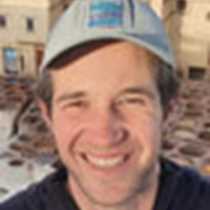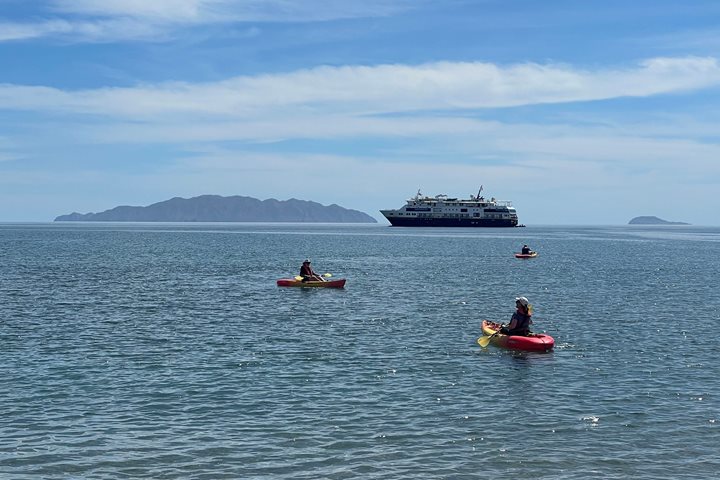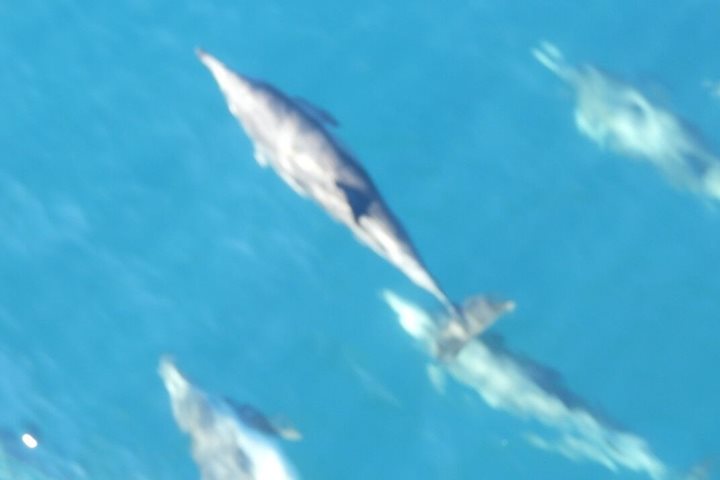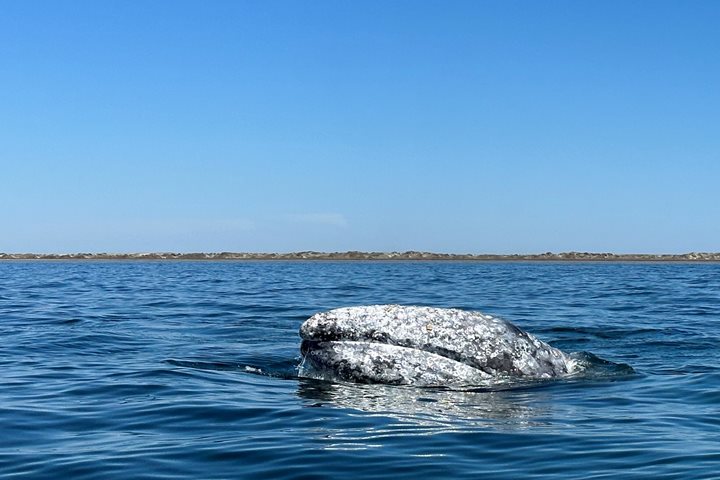Last night, we rounded the cape that forms the southern tip of the Baja California Peninsula and began making our way north through the open waters of the Pacific towards Magdalena Bay. The norteño winds were blowing, and the sea conditions were quite different from the flat, glassy waters we experienced earlier in the week. After breakfast, as National Geographic Venture advanced over the swells, a masked booby flew alongside us for several minutes, affording us excellent views of this beautiful seabird.
Over a third of our guests this week are part of a group organized by The Nature Conservancy (TNC), and this morning we enjoyed talks from two TNC guest presenters. Tom Dempsey’s talk, “Building Ocean Conservation Solutions for Scale,” focused on actions his team is taking to reduce two different types of adverse human impacts on whales – entanglements in fishing gear and ship strikes. TNC has partnered with fishing communities along the California Coast to create a robust recovery system for lost crab fishing gear, the loose vertical lines of which are one of the more common entanglement threats to whales. Containerships striking whales are often an invisible cause of whale mortality, and Tom also described his team’s vision to bring a “whale safe shipping” certification to the international container shipping industry. Having such a standard would recognize compliance with ship routes and speed restrictions and would allow merchandisers to apply market pressure to reward good behavior.
Soon after Tom finished fielding questions from guests, the expedition leader made an exciting announcement over the ship’s public address system: a killer whale had been sighted near the ship! National Geographic Venture slowed down and turned around to allow guests to come out to the bow to enjoy this sighting. The very tall, angular dorsal fin was indicative of an adult male killer whale, and it stayed near us for some time. Our position at the time was just offshore of the southern tip of Isla Margarita, near the Rehusa Channel, which forms the southernmost entrance to Magdalena Bay. Although gray whale calves and their highly protective mothers are inside the shallow waters of the bay, killer whales very rarely enter Baja California’s gray whale lagoons. Although we don’t fully understand why, our naturalists shared theories of why this might be. Once we got underway again, TNC’s Frank Hurd shared a great talk titled, “Sustainability through Partnership – Working with Fishing Communities to Ensure a Better Future for Marine Ecosystems & Everyone that Depends on Them.” Frank has worked closely with local fishing communities here in Baja California Sur and has helped them use scientific tools to create size limit restrictions that can protect their marine resources and future livelihoods. As we witnessed yesterday in Cabo Pulmo, the key elements to efforts like this being successful are initiation and ownership of regulations from within the community. TNC and its partners are working in many other geographies around the world to scale this community-driven, relationship-based approach to marine conservation.
Over lunch in the dining room, we breathed a sigh of relief as National Geographic Venture passed through La Entrada, the principal opening of Magdalena Bay to the Pacific. The seas calmed as we entered protected waters and saw our first gray whales of the trip. We enjoyed a presentation from naturalist Rich Kirchner on the “Birds of Baja” before anchoring just offshore of one of the narrowest parts of Isla Magdalena. Excited to stretch our legs and explore this new environment, we loaded Zodiacs to shuttle guests to the beach. In front of us, a sweeping expanse of barchan dunes formed an isthmus connecting Isla Magdalena’s rugged mountains of metamorphic rock to our south and north. These rocks are exotic terranes, accreted onto the edge of the continental plate millions of years ago. Ocean currents then deposited huge quantities of sand in this area, and these rocky outcrops were connected by dunes to form the barrier islands that separate Magdalena Bay from the open Pacific.
We broke into smaller, naturalist-led groups to explore this spectacular landscape of shifting sands. We saw shell middens left behind by inhabitants of this area thousands of years ago, fine grains of powdery sand blowing and cascading over the crescent-shaped dunes, succulents that are slowly managing to stabilize their dynamic environment, tracks of kangaroo rats, lizards, foxes, and coyotes, interesting plants such as satiny locoweed and Magdalena twinevine, and a loggerhead shrike perched atop an island of desert thorn. We crested the dunes and took in the sweeping views of Sand Dollar Beach and the waves of the open Pacific with all our senses. Now it was time to beachcomb! In addition to hundreds of sand dollar skeletons – and a few sand dollars that were still alive – we found an abundance of sea turtle ribs, crabs, bird skeletons, and shells left behind by mollusks such as cockles, scallops, and pen oysters…and much, much more. Exhilarated by the beauty of this special place and the joy of exploration, we eventually walked back across the dunes towards National Geographic Venture, glowing in the soft light of the late afternoon sun.
After cocktail hour and evening recap, the hotel team treated us to a Mexican fiesta in the dining room. We enjoyed ceviche, guacamole, tamales, and enchiladas mineras. We somehow managed to save a little space for delicious tres leches cake, and then we returned to the forward lounge one last time for a presentation by naturalist Megan Wehrenberg on mangrove ecosystems. Today was yet another full day, and we are excited for the opportunity to spend time searching for gray whales tomorrow!









